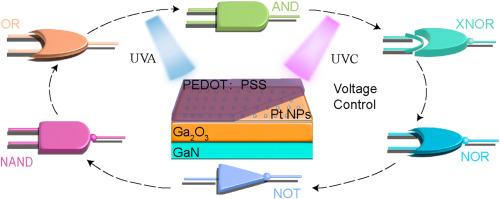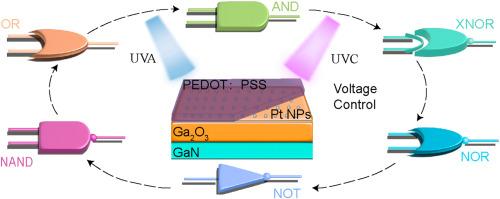Localized surface plasmon resonance-driven 71.9% EQE in Ga2O3 photodetectors: From photovoltaic enhancement to multifunctional optoelectronic logic gates integration
IF 9.7
2区 材料科学
Q1 MATERIALS SCIENCE, MULTIDISCIPLINARY
引用次数: 0
Abstract
Ga2O3-based photodetectors with dual-band response characteristics hold great promise for realizing multifunctional optoelectronic logic gates (OELGs) in digital computing and secure communication. In this work, a hybrid organic-inorganic heterojunction based on PEDOT:PSS/Pt NPs/Ga2O3/GaN is designed to overcome the zero-bias performance bottleneck of conventional Ga2O3 heterojunction photodetectors and to integrate multiple logic operations into a single device. Under 254 nm illumination and 0 V bias, the device achieves an ultra-high external quantum efficiency (EQE) of ∼71.9% via the localized surface plasmon resonance (LSPR) of platinum (Pt) nanoparticles (NPs) embedded at the PEDOT:PSS/Ga2O3 interface. Statistics from twelve additional devices yield a median EQE of 71.3%. When an external bias is applied, the photodetector exhibits a tunable dual-band response in the UVC and UVA regions. By programming the bias voltage and optical inputs, six reconfigurable logic functions (NOR, NOT, NAND, XNOR, OR, and AND) are realized within a single unit, demonstrating its potential for parallel optical computing. Additionally, an encryption communication system based on these OELGs validates their applicability in secure data transmission, where dual-band signals can be dynamically encoded and decoded.


局域表面等离子体共振驱动Ga2O3光电探测器中的71.9% EQE:从光伏增强到多功能光电逻辑门集成
具有双频响应特性的ga2o3光电探测器在实现数字计算和安全通信中的多功能光电逻辑门(OELGs)方面具有很大的前景。在这项工作中,设计了基于PEDOT: PSS/Pt NPs/Ga2O3/GaN的混合有机-无机异质结,以克服传统Ga2O3异质结光电探测器的零偏置性能瓶颈,并将多个逻辑运算集成到单个器件中。在254 nm光照和0 V偏置下,该器件通过嵌入PEDOT: PSS/Ga2O3界面的铂(Pt)纳米颗粒(NPs)的局部表面等离子体共振(LSPR)实现了高达71.9%的超高外量子效率(EQE)。另外12台设备的统计数据显示EQE的中位数为71.3%。当施加外部偏置时,光电探测器在UVC和UVA区域表现出可调谐的双波段响应。通过对偏置电压和光输入进行编程,在单个单元内实现了6个可重构逻辑功能(NOR、NOT、NAND、XNOR、OR和and),展示了其并行光学计算的潜力。此外,基于这些OELGs的加密通信系统验证了它们在安全数据传输中的适用性,其中双频信号可以动态编码和解码。
本文章由计算机程序翻译,如有差异,请以英文原文为准。
求助全文
约1分钟内获得全文
求助全文
来源期刊

Materials Today Physics
Materials Science-General Materials Science
CiteScore
14.00
自引率
7.80%
发文量
284
审稿时长
15 days
期刊介绍:
Materials Today Physics is a multi-disciplinary journal focused on the physics of materials, encompassing both the physical properties and materials synthesis. Operating at the interface of physics and materials science, this journal covers one of the largest and most dynamic fields within physical science. The forefront research in materials physics is driving advancements in new materials, uncovering new physics, and fostering novel applications at an unprecedented pace.
 求助内容:
求助内容: 应助结果提醒方式:
应助结果提醒方式:


